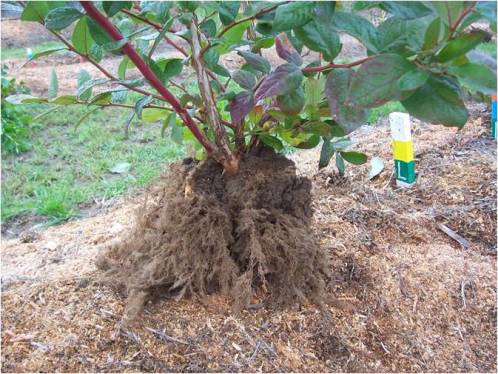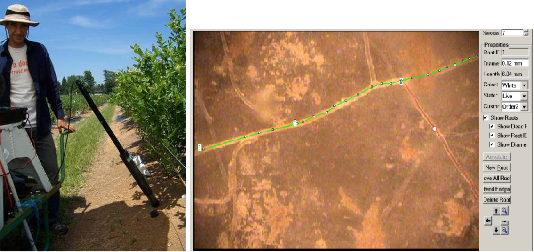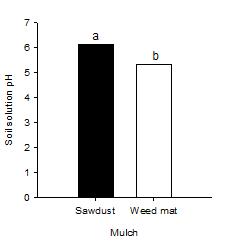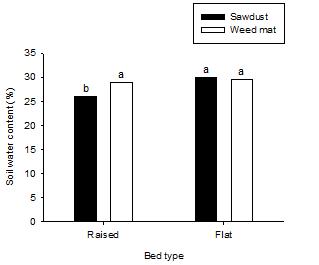eOrganic authors:
Dr. Luis R. Valenzuela-Estrada, Department of Horticulture, Oregon State University
Dr. David R. Bryla, USDA-ARS Horticultural Crops Research Unit, Corvallis, OR
Dr. Dan M. Sullivan, Department of Crop and Soil Science, Oregon State University
Dr. Bernadine C. Strik, Department of Horticulture, Oregon State University
This article provides general information on blueberry roots and highlights recent work on the topic as part of a multi-year research project investigating organic production options for highbush blueberry in the Pacific Northwest. For more information on this project, see Organic Blueberry Production Research Project.
Watch a video of Dr. Luis R. Valenzuela-Estrada, Oregon State University, discussing the root research
Introduction
Highbush blueberry roots are relatively shallow compared to other perennial fruit crops (Fig. 1). The roots are generally located in the top 1.5 feet (~0.5 m) of soil and are most concentrated near the soil surface. Nutrients are absorbed mostly through the finest roots. The average size of these fine roots is only about 20–75 micrometers in diameter (Valenzuela-Estrada et al., 2008). In comparison, a human hair is about 80 micrometers in diameter.

Figure 1. Root ball of a "Duke" blueberry plant. The plant was dug up in October 2007 after one growing season. Photo credit: Bernadine Strik, Oregon State University.
Highbush blueberries grow best on well-drained soils that have a high organic matter content and a pH of 4.2–5.5 (Strik et al., 1993). Blueberry plants, however, are relatively intolerant of high soil salt content, which is often measured as soil electrical conductivity (EC). Soil EC reflects the amount of nutrients, including nitrogen, in the soil solution. High EC values indicate an excess of nutrients that can damage the roots, stunt plant growth, and—in severe cases—kill the plants.
Objective and Research questions
Objective: Evaluate the effects of organic management systems on soil water and nutrient availability and the distribution of blueberry roots. The management systems being compared include flat vs. raised planting beds, sawdust mulch vs. weed mat (used for weed control), and two different rates of organic fish fertilizer: 25 and 50 lb/acre of N (29 and 57 kg/ha of N).The timing of new root development is also being examined. The knowledge of when new root growth occurs will be useful for determining when and where irrigation water and fertilizers should be applied.
Methods of investigation
Roots are monitored in this study by way of a series of digital photographs, which are taken in the soil every two weeks (Fig. 2). The photographs are taken inside clear plastic tubes, referred to as minirhizotrons, which are installed near the plants at a depth of approximately 2 feet (60 cm). From these images, information is gathered about when new roots appear and when old roots die, the total number of new roots produced on the windows, root diameter and length, and any changes in root color.

Figure 2. [left] Minirhizotron camera used to photograph roots of a blueberry plant in the field at the OSU North Willamette Research & Extension Center. [right] An image of blueberry roots taken with the minirhizotron camera. Roots are highlighted (red line = first-order root; green line = second-order root) using computer software designed to measure root characteristics. Photo credit: Luis Valenzuela, Oregon State University.
The fertility available to the roots is monitored using plant-root simulator probes (PRS probes). The PRS probes absorb nutrients in a manner similar to plant roots and are used to evaluate the total amount of soil nutrients available to the plants. Soil solution is also being analyzed. Soil solution is extracted with syringe-like devices called suction lysimeters. The lysimeters are buried at two different soil depths, 6–10 inches (15–25 cm) and 14–18 inches (35–45 cm), which represent the predominant rooting depth and below, respectively. The pH, EC, and nitrogen (nitrate and ammonium) concentration of the soil solution is then determined in the laboratory. Finally, soil water content is measured at 0–30 cm depth by time-domain reflectometry (TDR).
Findings to date
Root growth
After the first three years of the experiment, the plants produced more roots (1) in raised beds than in flat beds, (2) with sawdust mulch than with weed mat, and (3) with the lower rate of fish fertilizer than with higher rate of fertilizer (Fig. 3). Plants on raised beds and grown with less fertilizer also produced deeper roots (Fig. 4). In 2009, during the third year after planting, a flush of new root growth was observed immediately after fruit harvest (data not shown).
Figure 3. Effects of bed type (A), weed control method (B), and amount of organic fish fertilizer (C) on new root production in "Duke" blueberry. Different letters above the bars indicate a significant difference at P = 0.05.
Figure 4. Effects of bed type (A) and amount of organic fish fertilizer (B) on the depth of new root production in "Duke" blueberry. Roots were measured at 0–30 cm (0–12 in.) and 30–50 cm (12–20 in.) soil depths. Different letters beside the bars indicate a significant difference at P = 0.05 and NS = non-significant.
Soil pH
While soil pH was higher under weed mat than under sawdust mulch (data not shown), soil solution pH was about a unit lower under weed mat than under sawdust mulch (Fig. 5). This was unexpected because Douglas fir sawdust has a pH of about 4.1 and therefore is usually thought to lower soil pH.

Figure 5. Soil solution pH under weed mat and sawdust mulch. Different letters above the bars indicate a significant difference at P = 0.05.
Soil EC
Soil solution EC level was very low (less than 0.3 mS/cm) at both the low and high fertilizer rates, which indicates both rates were low enough to avoid salt injury to the plants. Blueberries are considered sensitive to soluble salt concentrations above 2 mS/cm.
Soil N
Total nitrogen (nitrate and ammonium) availability was higher, as expected, when more fertilizer was applied, but was similar in raised and flat beds, as well as under sawdust mulch and weed mat.
Soil water content
Although more irrigation water was applied to raised beds than to flat beds, raised beds with sawdust mulch generally had lower soil water content than raised beds with weed mat, or than flat beds with sawdust or weed mat (Fig. 6). Differences in irrigation and soil water content often affect soil chemistry and root dynamics and therefore may account for some of the differences in root production observed in the present study. For example, less soil water content in the raised beds may have resulted in more root production in the beds (Fig. 3A). Lower soil water content may have also increased root production under sawdust (Fig. 3B), although daytime soil temperature was also lower under sawdust, particularly in late July and early August after harvest (data not shown).

Figure 6. Soil water content measured at a depth of 0–30 cm in flat and raised beds covered with sawdust mulch or weed mat. Values were averaged over the 2009 season. Different letters indicate a significant difference among treatments at P = 0.05.
References and Citations
- Strik, B., C. Brun, M. Ahmedullah, A. Antonelli, L. Askham, D. Barney, P. Bristow, G. Fisher, J. Hart, and D. Havens. 1993. Highbush blueberry production. Pacific Northwest Extension Publication 215. (Available online at http://extension.oregonstate.edu/catalog/abstract.php?seriesno=PNW+215) (verified 26 January, 2011).
- Valenzuela-Estrada, L. R., D. M. Eissenstat, L. E. Ruth, and V. Vera-Caraballo. 2008. Root anatomy, morphology, and longevity among root orders in Vaccinium corymbosum (Ericaceae). American Journal of Botany 95: 1506–1514. (Available online at http://www.amjbot.org/cgi/content/abstract/95/12/1506) (verified 27 January, 2011).
Additional Resources
- Waisel, Y., A. Eshel, and U. Kafkafi (ed.) 2002. Plant roots: The hidden half. Third edition. CRC Press, Boca Raton, FL.




